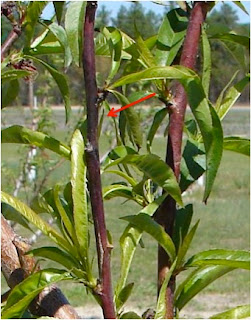 | ||
| Robber fly eating Japanese beetle (Photo D. Stephan) |
Japanese beetles emerge once per year to feast on a variety of ornamental and crop plants. Their favorite ornamental hosts include roses, rosaceous trees, shrubs such as crab apple, crape myrtle and linden, grape, and fruit trees.
Typically, Japanese beetles feed on the upper leaf surface eating the tissue between leaf veins. This gives the leaves a lacy appearance, a type of damage called skeletonizing.
 | ||
| Japanese beetle and skeletonizing damage (Photo: B. Shew) |
 |
| Japanese beetle damage (Photo: B. Shew) |
The beetle grubs may be serious pests of the roots of grasses and shrubs, especially on turf farms and golf courses. They burrow through the soil feeding on roots. This can result in areas of dead grass. The grubs overwinter deeper in the soil, and in the spring, they move just below ground level, complete feeding, and pupate. New beetles emerge from pupae in late spring to start the cycle again.
Japanese beetles can fly long distances, so beetle traps do not offer any protection to landscape plants. They may actually attract more beetles to your yard! Likewise, treating a lawn for Japanese beetle grubs will not reduce damage from incoming beetles.
Long-term protection for landscape and nursery plants can be achieved through the use of neonicotinoid insecticides such as imidacloprid (e.g., Merit, Marathon II) or acetamiprid (Tri-Star). Acelepryn (chlorantraniliprole) is a new product with extremely low vertebrate toxicity but good efficacy against a number of pests, including Japanese beetles.
 |
| Japanese beetle on flower (Photo: B. Shew) |
http://www.ces.ncsu.edu/depts/ent/notes/O&T/flowers/note147/note147.html
http://www.ces.ncsu.edu/depts/ent/notes/O&T/flowers/note44/note44.html
Special thanks to Steve Bambara and Dave Stephan for their help with this post!


















